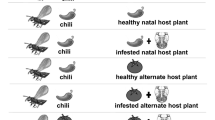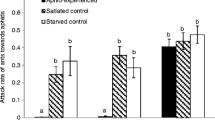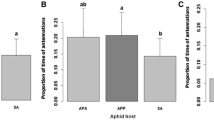Abstract
Parasitoid foraging behaviour is known to be influenced by interactions of genetic, physiological, environmental and experiential factors. Although the role of genetics, learning and conditioning in determining responses to foraging cues has been studied in lepidopteran parasitoids, aphid parasitoids have been less intensively researched. Using the tritrophic system,Vicia faba — Acyrthosiphon pisum — Aphidius ervi, evidence for the role of genetics and learning in parasitoid foraging is presented, and the difficulty of differentiating between genetic responses and those conditioned during parasitoid development is discussed.
Aphidius ervi responds to aphid sex pheromones both in the field and in the laboratory. Since laboratory reared individuals have never experienced sexual aphids, the response must be genetic as it cannot have been conditioned during development. An example of a response conditioned during development is the variable response ofA. rhopalosiphi to different wheat cultivars depending upon host feeding. Aphid parasitoids also are adept at learning as shown by their responses to plant-derived cues which are learnt as Conditioned Stimuli (CS). Host products such as honeydew, as well as the host itself, can act as the Unconditioned Stimulus (US) in the learning process.
Aphidius ervi offers a good model for investigating the role of these factors in parasitoid foraging behaviour. Finally, the value of such research for biological control programmes involving aphid parasitoids is discussed.
Résumé
Le comportement de recherche d’hôtes d’un parasitoïde est connu pour être influencé par des interactions entre facteurs d’ordre génétique, physiologique, environmental et l’apprentissage. Bien que le rôle de la génétique, de l’apprentissage et du conditionnement dans la détermination de la réponse aux stimuli permettant de trouver l’hôte ait été étudié chez les parasitoïdes de Lépidoptères, les parasitoïdes de pucerons ont fait l’objet de recherches plus limitées. En utilisant le système tri-trophique,Vicia faba-Acyrtosiphon pisum-Aphidius ervi, le rôle de la génétique et de l’apprentissage dans le comportement de recherche de l’hôte par les parasitoïdes est mis en évidence, et la difficulté de distinguer entre les réponses d’ordre génétique et celles dues au conditionnement pendant le développement du parasitoïde est discutée.
Aphidius ervi est sensible aux phéromones sexuelles du puceron aussi bien en champ qu’en laboratoire. Comme les individus élevés en laboratoire n’ont jamais connu de pucerons de forme sexuée, la réponse doit être génétique puisqu’ils ne peuvent pas avoir été conditionnés durant leur développement. Un exemple de réponse conditionnée lors du développement est la réponse variable d’A. rhopalosiphi à différents cultivars de blé en fonction de l’alimentation de l’hôte. Les parasitoides de puceron sont également doués pour l’apprentissage, comme le montrent leurs réponses aux extraits de plantes qui sont considérées comme Stimuli induits par le Conditionnement. Les productions provenant des hôtes telles que le miellat, aussi bien que l’hôte lui-même, peuvent agir comme stimuli non induits par le conditionnement dans le processus de l’apprentissage.
A. ervi constitue un bon modèle pour étudier le rôle de ces facteurs dans le comportement de recherche de l’hôte par le parasitoïde. Enfin il est discuté de l’intérêt d’une telle recherche pour les programmes de lutte biologique impliquant des parasitoïdes de pucerons.
Similar content being viewed by others
References
Budenberg, W. J. — 1990. Honeydew as a contact kairomone for aphid parasitoids. —Entomol. Exp. Appl., 55, 139–148.
Corbet, S. A. — 1985. Insect chemosensory responses: a chemical legacy hypothesis. —Ecol. Entomol., 10, 143–153.
Du, Y.-J., Poppy, G. M. & Powell, W. — 1996. Relative importance of semiochemicals from the first and second trophic level in host foraging behavior ofAphidius ervi. —J. Chem. Ecol.
Du, Y.-J., Poppy, G. M., Powell, W. & Wadhams, L. J. — 1997. Chemically-mediated associative learning in the host foraging behaviour of the aphid parasitoidAphidius ervi (Hymenoptera: Braconidae). —J. Insect Behav, in press.
Grasswitz, T. R. &Paine, T. D. — 1993a. Effect of experience on in-flight orientation to host-associated cues in the generalist parasitoidLysiphlebus testaceipes. —Entomol. Exp. Appl., 68, 219–229.
Grasswitz, T. R. &Paine, T. D. — 1993b. Influence of physiological state and experience on the responsiveness ofLysiphlebus testaceipes (Cresson) (Hymenoptera: Aphidiidae). —J. Insect Behav., 6, 511–528.
Guerrieri, E., Pennacchio, F. &Tremblay, E. — 1993. Flight behaviour of the aphid parasitoid Aphidius ervi (Hymenoptera: Braconidae) in response to plant and host volatiles. —Eur. J. Entomol., 90, 415–421.
Hågvar, E. B. &Hofsvang, T. — 1991. Aphid parasitoids (Hymenoptera, Aphidiidae): biology, host selection and use in biological control. —Biocontrol News Inf., 12, 13–41.
Hardie, J., Nottingham, S. F., Powell, W. &Wadhams, L. J. — 1991. Synthetic aphid sex pheromone lures female parasitoids. —Entomol. Exp. Appl., 61, 97–99.
Hughes, R. D. — 1989. Biological control in three open field. In: Aphids, their biology, natural enemies and control. World Crop Pests. (A. K. Minks &Harrewijn, P., eds.). —Elsevier, Amsterdam, 167–198.
Lewis, W. J. &Martin, W. R. Jr. — 1990. Semiochemicals for use with parasitoids: Status and future. —J. Chem. Ecol., 16, 3067–89.
Papaj, D. R., &Lewis, A. C. — 1993. Insect Learning. Ecology and Evolutionary Perspectives.Chapman & Hall, New York 398 p.
Powell, W. — 1986. Enhancing parasitoid activity in crops. In: Insect Parasitoids (D. J. Greathead &J. Waage, eds.) —Academic Press, London, 319–340.
Powell, W., Hardie, J., Hick, A. J., Höller, C., Mann, J., Merritt, L., Nottingham, S. F., Wadhams, L. J., Witthinrich, J., &Wright, A. F. — 1993. Responses of the parasitoidPraon volucre (Hymenoptera: Braconidae) to aphid sex pheromone lures in cereal fields in autumn: Implications for parasitoid manipulation. —Eur. J. Entomol., 90, 435–438.
Sheehan, W., &Shelton, A. M. — 1989. The role of experience in plant foraging by the aphid parasitoidDiaeretiella rapae (Hymenoptera Aphidiidae). —J. Insect Behav., 2, 743–758.
Stowe, M. K., Turlings, T. C. J., Loughrin, J. H., Lewis, W. J. &Tumlinson, J. H. — 1995. The chemistry of eavesdropping, alarm, and deceit. —Proc. Natl. Acad. Sci. USA, 92, 23–28.
Tumlinson, J. H., Turlings, T. C. J. &Lewis, W. J. — 1992. The semiochemical complexes that mediate insect parasitoid foraging. —Agric. Zool. Rev., 5, 221–252.
Turlings, T. C. J., Wäckers, F. L., Vet, L. E. M., Lewis, W. J. &Tumlinson, J. H. — 1993. Learning of host-finding cues by Hymenopterous parasitoids. In: Insect Learning. Ecological and Evolutionary Aspects (D. R. Papaj &A. C. Lewis, eds.). —Chapman and Hall, New York, 51–78.
Van Emden, H. F. — 1996. Responses of parasitoids of aphids to olfactory cues of the host plant of their prey. —Proceedings of the XX International Congress of Entomology, Firenze, August 1996, 645.
Vet, L. E. M. — 1995. Parasitoid foraging: the importance of variation in individual behaviour for population dynamics. In: Frontiers of population ecology (R. B. Floyd &A. W. Sheppard, eds.). —CSIRO Publications, Melbourne, Australia.
Vet, L. E. M., Lewis, W.J. Papaj, D.R. &van Lenteren, J.C. — 1990. A variable-response model for parasitoid foraging behaviour. —J. Insect Behav. 3, 471–489.
Vet, L. E. M. &Dicke, M. — 1992. Ecology of infochemical use by natural enemies in a tritrophic context. —Annu. Rev. Entomol., 37, 141–172.
Vinson, S. B. — 1985. The behaviour of parasitoids. In: Comprehensive Insect Physiology Biochemistry and Pharmacology. Vol. 9 (G. A. Kerkut &L. I. Gilbert, eds.). —Pergamon Press, Oxford, 417–469.
Wickremasinghe, M. G. V. &van Emden, H. F. — 1992. Reactions of adult female parasitoids, particularlyAphidius rhopalosiphi, to volatile cues from the host plants of their aphid prey. —Physiol. Entomol., 17, 297–304.
Wratten, S. D., &Powell, W. — 1991. Cereal aphids and their natural enemies. In: The ecology of temperate cereal fields (L. G. Firbank, N. Carter, J. F. Darbyshire &G. R. Potts, eds.). —Blackwell, Oxford, 233–257.
Author information
Authors and Affiliations
Rights and permissions
About this article
Cite this article
Poppy, G.M., Powell, W. & Pennacchio, F. Aphid parasitoid responses to semiochemicals — Genetic, conditioned or learnt?. BioControl 42, 193–199 (1997). https://doi.org/10.1007/BF02769897
Published:
Issue Date:
DOI: https://doi.org/10.1007/BF02769897




